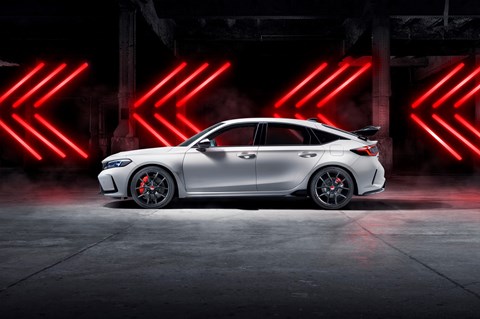► The new Type R in more detail
► FL5 aims to sell even more than the previous car
► Coming to Europe in early 2023
You’re looking at the next Honda Civic Type R – no, really. Codenamed FL5, the next Type R looks far tamer than what came before, but underneath it’s anything but. Simultaneously more extreme on the inside and less polarizing on the outside, it’s designed to be the most complete Type R yet.
What’s new?
‘With this generation, we tried to incorporate all the efficient and effective aerodynamic measures and wrapped them in an elegant shell,’ Kotaro Yamamoto, technical advisor of Honda Motor Europe tells CAR while pointing out the FL5’s uncluttered lines.

Gone are the pronounced wheel arches of the previous gen, and with them the fake carbonfibre and cul-de-sac vents. Even the wheels are smaller this time around too (from 20-inches to 19-) though a ‘reverse-rim’ construction means you can hardly tell. The wider, more open, part of the alloy now faces outwards rather than inwards, giving the illusion of a bigger rim.
Read our passenger ride of the new Honda Civic Type R here
Is it still like a Type R though?
At the rear, the new car sports a thoroughly re-designed wing. Smaller than the Star-Wars number slung on the back of the old car, it’s an intricate affair with die-cast aluminium supports. Alongside reducing weight, these trick struts take up less of the wing’s surface area – crucially leaving more of it to generate downforce. When combined with a Type R-specific hood, bumper, skirt and diffuser, downforce is up to 900nm at 124mph.

Look further down and you’ll see a triple-pipe configuration similar to the old car, only here it’s reversed: two smaller pipes sit either side of a larger one, with all three nestled into a new diffuser.
What about the tech specs?
Every aspect has of the car has seen small but noticeable gains: the Brembo brakes return, though everything around them is different. ‘What we’ve changed significantly is the cooling,’ Yamamoto says, while showing us a new duct in the front wheel arch and a set of vents behind it. Both work in tandem to push cool air through the brakes and pull hot air out, improving their endurance in sustained use – and reducing drag.

Is the engine new?
A reworked version of the turbocharged 2.0-litre four-cylinder sits underneath the new Type R’s bonnet and benefits from a more compact turbo with stronger, lighter blades. ‘What has reduced is the inertia of the turbine itself. By reducing that weight, it is reacting much quicker and building up the boost pressure much, much quicker,’ Yamamoto explains.

‘That gives better response but also more airflow to improve the efficiency of the turbo. They can also pump more air into the cylinder. That is the key technology this time for the output increase.’ he adds.
And what output increase? Yamamoto won’t budge and Honda won’t release the Civic’s new power figures until after homologation – but our passenger lap makes us think the 2023 Type R is knocking on Focus RS power.

A 340bhp power figure and 5-second 0-62mph sprint aren’t out of the question – but unlike the fast Ford, power is driven entirely through the front axle. Honda’s dedication to two-wheel drive means this Civic Type R still feels particularly agile compared to its four-wheel-drive competition, though no official weight figures have been released.
And that all important shift?
The new powertrain is mated to a manual six-speed ‘box, though this hasn’t been immune to tinkering either. Rev matching was a plus on the old car, but it’s again improved here, and is now both quicker and available through all gears. ‘The former Civic Type R wouldn’t do a rev match when shifting from second to first,’ Yamamoto reminds us. ‘But now it does.’

What’s the interior like?
Honda has worked hard to improve the perceived quality of the new car, and it starts with the new seating position. ‘You’re sitting slightly lower than the previous generation. I think also the overall height of the car is lower,’ Yamamoto tells us, as we get comfortable behind the wheel.
Directly ahead in the driver’s line of sight lies an arc of old-school LEDs, replacing the virtual TFT lights from the last Type R. They light up near the upper reaches of the rev range as you hone in on the redline.

Like the previous gen, the new car also features a range of driver modes – but new for the FL5 is an Individual mode. Allowing the driver to swap and choose between suspension, powertrains, engine sound and other settings, it’s yet another step towards a more complete, more mature product.
How much?
Featuring serious engineering and more palatable looks, Honda engineers believe this car has everything it needs to retain the hot-hatch crown, while appearing to a larger range of customers. There’s no word on pricing yet, but this feels like a car that costs upwards of the FK8’s £31k price tag.
It’ll be released in Europe in 2023, though we’ll get firm facts and figures ideally later this year.
